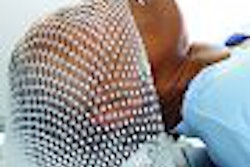Frameless stereotactic radiosurgery treatments are proving effective in relieving intense facial pain associated with trigeminal neuralgia, according to a study published online in the Journal of NeuroInterventional Surgery, part of the British Medical Journal (BMJ) Group.
Patients with trigeminal neuralgia, also known as tic douloureux, experience a constant sharp, stabbing pain or burning sensation affecting the jaw or cheek. While brief, these episodes are recurrent and debilitating. The pain historically has been treated with surgery or anticonvulsant and antidepressant medications. The condition affects four to five people out of every 100,000.
Physicians at Winthrop-University Hospital in Mineola, New York, reported on the outcomes of 17 consecutive patients who underwent stereotactic radiosurgery (CyberKnife, Accuray) between May 2007 and July 2009. The patients, who were between ages 36 and 90, had had their symptoms for one to 11 years and had not responded to the available treatment options (JNIS, 25 January 2012).
All patients underwent CT cisternography, a radiographic study of the basal cisterns of the brain using a low-osmolar iodine contrast medium, for treatment planning. The target segment was consistently defined as a 6-mm-length of nerve approximately 2-3 mm distal to the dorsal root entry zone of the brainstem.
The patients underwent a radiosurgical rhizotomy using a single 5- or 7.5-mm collimator to deliver an average maximum radiation dose of 73.06 Gy. The mean target volume was 73.02 mm, with a range of 39.74 to 145.74 mm, according to radiology department chairman Dr. Orlando Ortiz and a co-author of the study.
Fourteen of the patients obtained either partial or complete relief from their symptoms. On average, this occurred within two months following treatment. Four patients experienced a relapse in symptoms three to 18 months following treatment. Only two patients reported sensory side effects in their jaws, and none of the patients had substantial complications relating to the stereotactic radiosurgery.
Acknowledging that the patients were followed for only a short time period, from one to 27 months, with a median of a year, and that their number was very small, the authors recommended that future studies of nonisocentric radiosurgery be performed. They specifically recommended that studies comparing the CyberKnife, the Gamma Knife Elekta, and surgical treatment be performed.



















